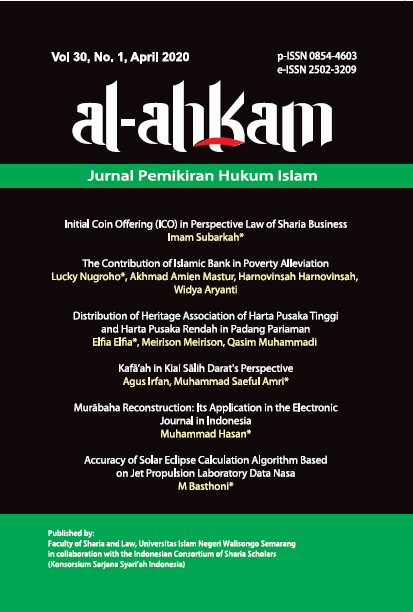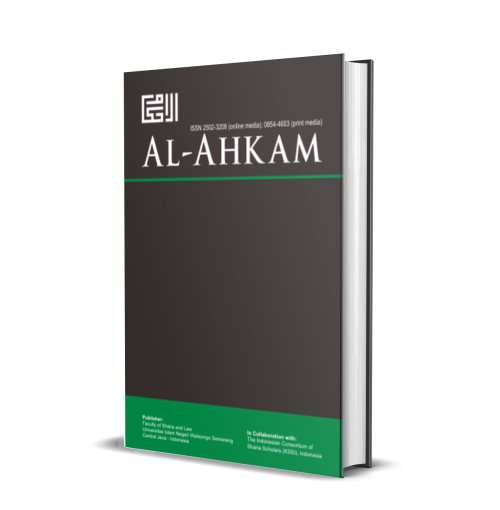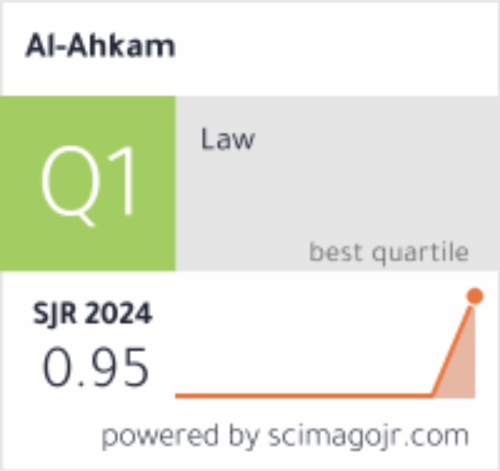Distribution of Heritage Association of Harta Pusaka Tinggi And Harta Pusaka Rendah in Padang Pariaman
DOI:
https://doi.org/10.21580/ahkam.2020.30.1.5273Keywords:
inheritance, pusaka tinggi, pusaka rendah, farā’iḍAbstract
This research is motivated by a phenomenon of the distribution of inheritance that occurs in the Nagari Lurah Ampalu community. They hand over inheritance (pusako rendah) at the pusaka tingg" property to girls. Some of the problems in this study are, the factors causing the community to divide pusaka tinggi and pusaka rendah are not based on Islamic law and the method of settlement by Shari'a for the two types of inherited assets that have been mixed. Data in this paper were obtained through interviews and documentation. The factors causing the community to share this inheritance are derived from the traditions of previous ancestors, the lack of community knowledge in faraid science and the existence of coercion between heirs. The solution used by local clerics is to calculate the price of pusaka tinggi land and the proceeds of the sale are left to the pusaka tinggi property holders. Assets that are on ancestral inheritance are distributed to heirs according to the law of farā'iḍ. The final solution is to move or eliminate assets above pusaka tinggi .
Downloads
References
Anwar, Chairul. Hukum Adat Indonesia: Meninjau Hukum Adat Minangkabau. Jakarta: Rineka Cipta, 1997.
Bapayuang, Amir M.S Magek. Adat Minangkabau Pola dan Tujuan Hidup Orang Minang. Jakarta: Citra Harta Prima, 2011.
Barlinti, Yeni Salma. ‘Inheritance Legal System in Indonesia: A Legal Justice for People’. Indonesia Law Review 3, no. 1 (2014).
Diyantari, Irawaty Irawaty; Diyantari. ‘Inheritance Laws in Indonesia’. Hayula: Indonesian Journal of Multidisciplinary Islamic Studies 1, no. 2 (2017).
Huda, Yasrul. ‘Islamic Law Versus Adat: Debate about Inheritance Law and the Rise of Capitalism in Minangkabau’. Studia Islamika2 15, no. 2 (2008). http://journal.uinjkt.ac.id/index.php/studia-islamika/article/view/531.
J, Iman. ‘Normative Analysis Approach: Status and Rights of a Daughter under Islamic Inheritance Law in Indonesia’. Sociology and Criminology 4, no. 2 (2016).
Kama, Iskandar. Beberapa Aspek dari Hukum Kewarisan Matrilineal Kebilateral di Minangkabau, dalam Mukhtar Naim. Padang: Center for Minangkabau Studies, 1968.
Kamaluddin, Safruddin Halimi. Adat Minangkabau dalam Perspektif Hukum Islam Analisa Fiqh terhadap Sistem Matrilineal, Larangan Kawin Sesuku dan Hukum Waris Adat Minangkabau. Padang: Hayfa, 2005.
Marsden, William. The History of Sumatra : Containing an Account of the Government, Laws, Customs, and Manners of the Native Inhabitants, with a Description of the Natural Production, and a Relation of the Ancient Political State of That Island. London: W. Marsden, 1783.
Sabiq, Sayyid. Fiqih Sunnah. Jakarta: Pena Pundi Aksara, 2006.
Sutan, Manan Rajo Panghulu Mahmud. Himpunan Tambo Minangkabau dan Bukti Sejarah. Bukittinggi: Ma’arif, 1978.
Syarifuddin, Amir. Hukum Kewarisan Islam. Jakarta: Kencana, 2005.
Syarifuddin, Amir. Pelaksanaan Hukum Kewarisan Islam dalam Lingkungan Adat Minangkabau. Jakarta: Gunung Agung, 1994.
Downloads
Published
How to Cite
Issue
Section
License
By submitting an article to the journal, the author(s) agree to transfer the published article's copyright to the journal, which will act as the publisher. This means the journal will have the right to publish the article in various forms, including reprints. The journal will maintain the publishing rights to the published articles.
In line with the license, authors and third parties (readers, researchers, and others) are allowed to share and adapt the material. In addition, the material must be given appropriate credit, provided with a link to the license, and indicated if changes were made. If authors remix, transform or build upon the material, authors must distribute their contributions under the same license as the original.




